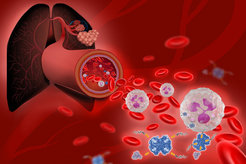Toxin, trauma, therapy?
Bacterial toxins could reduce the impact of traumatic injuries
The treatment of sequelae of chest trauma is of current research interest. The department of Prof. Tanja Weil at the Max Planck Institute for Polymer Research has, in cooperation with the group of Prof. Holger Barth from the Institute of Pharmacology and Toxicology at the Ulm University, shown in initial laboratory tests that they are able to specifically modulate processes in human white blood cells (leucocytes) in vitro, which are relevant for their movement, by using bacterial toxins. This could lead to a targeted reduction of secondary diseases following trauma, which could represent an important step in the development of future therapies.
Massive tissue and organ injuries, bone fractures - so-called traumata - such as those that can occur in car accidents, activate the natural repair system in the human body in order to prevent further damage and promote healing. For this purpose, white blood cells - so-called leukocytes – are recruited to the site of the injury, e.g. the lungs. However, this increased recruitment can also disrupt the barrier between the blood vessels and the alveoli. As a result, fluid can accumulate in the lungs and inflammation mediators are excessively produced and released into the blood.

Scientists have now achieved initial successes in modulating processes associated with the mobility of white blood cells in vitro. They hope to be able to reduce the aftermath of a blunt chest trauma, for example. Their method is based on the internal driving motor of the white blood cells, the so-called cytoskeleton, which enables the cells to move in the body. This motor consists of molecules that combine to long chains - so-called polymers - and then convert back to single molecules again. "You can imagine the white blood cells as a submarine in the bloodstream," says Dr. Seah-Ling Kuan, group leader at the MPI-P in the department of Tanja Weil. "The conversion process back and forth is like a small, molecular motor that advances the submarine. But, of course, it has to be driven by a fuel.”
The researchers have now found a pharmacological way to specifically turn off the "fuel" required by the white blood cells and thus might control processes associated with their mobility. They have used a platform consisting of the protein "avidin" for this purpose. Avidin can be imagined as a small Lego brick with four studs to which other building blocks can be attached. "We have now attached a so-called peptide with special properties to three of the binding sites of avidin: The peptide is constructed in such a way that it can dock directly to a specific part of the white blood cells, i.e. it can act like an anchor," says Seah-Ling Kuan. The scientists assigned the fourth binding site to a special bacterial toxin. "The toxin specifically intervenes with a complex molecular signal process chain and literally turns off the fuel source," says Prof. Holger Barth from the Institute of Pharmacology and Toxicology at the Ulm University, who is testing the effect of the construct on white blood cells with his group.
With their new avidin-based platform, the scientists have created a possibility to specifically address leukocytes and, with the help of a specific toxin-derived enzyme, to modulate processes which are associated with the supply of energy for the molecular processes that let them move in the body.
The scientists are carrying out their research within the framework of the Collaborative Research Centre 1149, in which groups from the Ulm University and the Max Planck Institute for Polymer Research work together. The aim is to investigate and understand the exact biological processes of trauma in more detail and to develop effective therapeutic approaches for accompanying symptoms. The researchers have now published their work in the renowned journal "Advanced Healthcare Materials".












